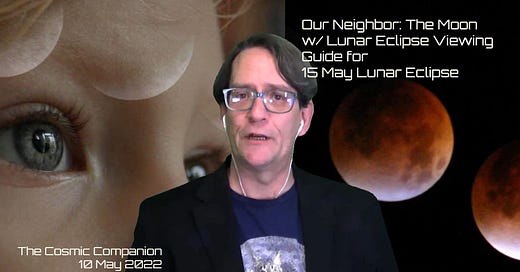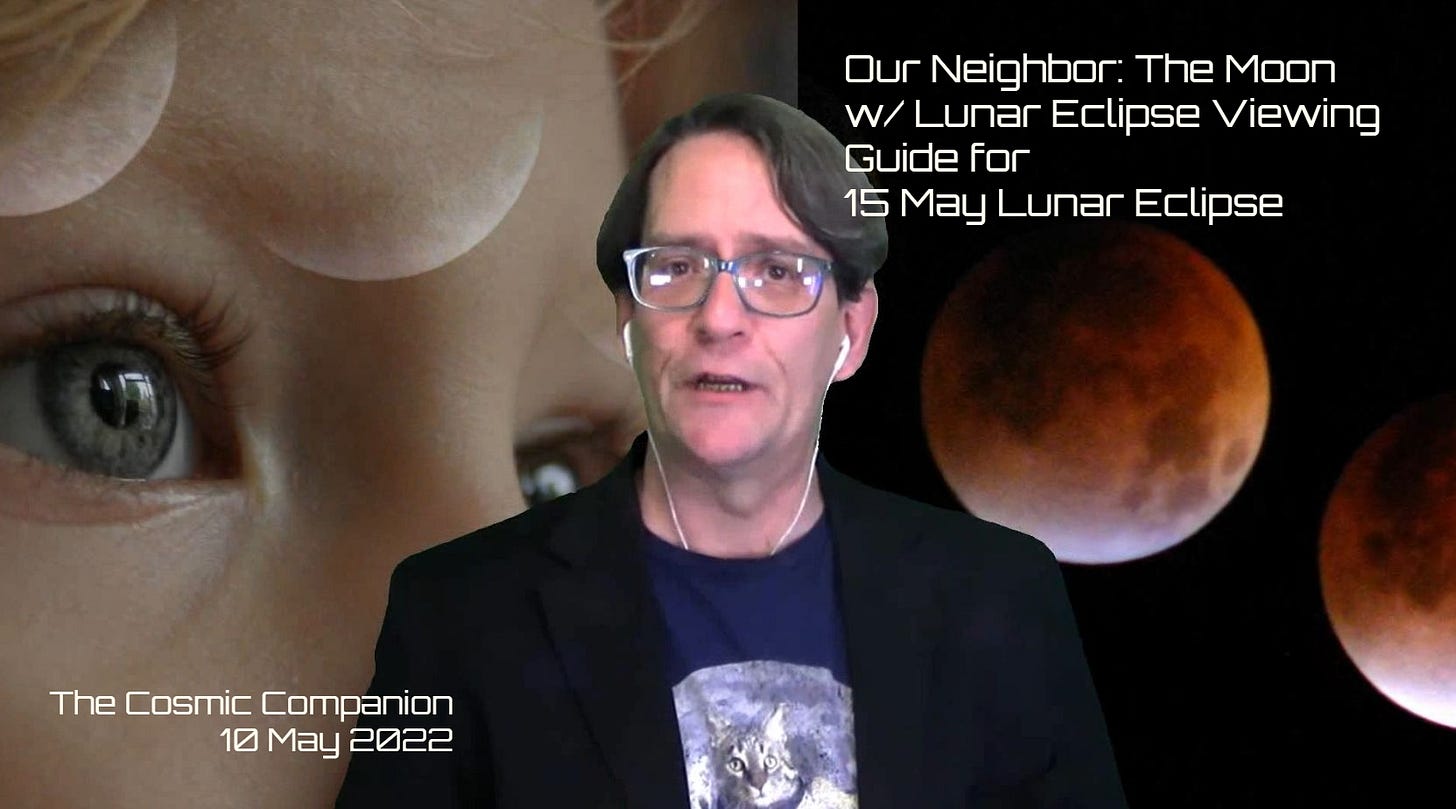The May 15 Lunar Eclipse gives us a perfect reason for Exploring Our Neighbor: The Moon! Features lunar eclipse viewing guide for Sunday's celestial event!
The Moon — our neighbor in space — appears serene and tranquil from the surface of the Earth. However, our passive planetary partner has a dramatic history full of violent impacts, which began with its birth in the chaos of the young solar system.
Roughly 4.5 billion years ago, our planet was a far different place than it is today. The nascent Earth was a lava world, orbiting an infant star, surrounded by billions of pieces of debris zipping through space.
For several million years, a Mars-sized body called Theia orbited the Sun along with Earth, often passing the orbit of the infant Earth. Eventually, these worlds collided, changing our planet forever.
(full transcript continues below for VIP subscribers!)
Next week: Children Taking a Bite of Science! with Kelly Hargrave, author of Can’t Get Enough Shark Stuff, a new release from National Geographic!
Thanks for subscribing!
Clear skies!
James
VIP Extra:
(transcript, continued)
During the course of the massive impact, Theia shattered, wreaking havoc with our own world. The core of the Mars-sized crunchy impactor merged with Earth’s gooey center, while other pieces fragmented, entering orbit around Earth. These remnants quickly came together, eventually forming the Moon. This may have happened in less than 100 years. The oldest rocks on the Moon formed an ocean of liquid magma.
At the time, the Moon was much closer to the Earth than it is today. During its earliest era, the infant Luna was separated from our planet by a distance of a little over 25,000 kilometers — less than seven percent of the distance it holds today. On the Earth, entire days lasted just six hours.
Evidence for this Great Impact hypothesis includes the vast amount of rotational energy still held by the pair of bodies, the extremely light core of the Moon, and a lack of water and gases held within the lunar crust.
For 600 million years, the Moon, along with Earth, were continually pelted by asteroids and comets. These events created some of the largest impacts we see on the Moon today.
As the crust of the young Moon solidified, hot magma seeped through cracks in the crust, which cooled, forming the dark, smooth maria, or seas, which we still see as we look up at the Moon.
For the last billion years, the Moon has remained a relatively quiet place in terms of geology.
Nearly every child recognizes the phases of the Moon, as our planetary comrade appears to change from night to night as it goes about its orbital dance with the Earth.
Once in a while, the Moon passes into the shadow cast through space by Earth. During these lunar eclipses, light from the lunar surface turns red, and our planetary companion can even seem to disappear.
Sky gazers across most of the Americas and western Europe will have a chance to witness such a total lunar eclipse on the night of 15 May.
The exact time of the eclipse, and what you might be able to see depends, in large part, on where one lives.
For viewers in the southwest, the eclipse will just be starting at moonrise around 7pm, becoming most dramatic around 9pm PDT (midnight EDT), and tapering off starting just before 11 on the west coast (2am Eastern).
The orbit of the Moon around Earth is tilted by about five degrees from the orbit of the Earth around the Sun. This tilt is the reason that lunar eclipses do not take place every month as the Moon slips behind the Earth. However, occasionally, the Moon does slip into the shadow of its larger companion.
The shadow of Earth has a larger, more diffuse outer region, surrounding a darker cone. When the Moon passes through this outer layer of shadow, it dims slightly, producing a penumbral eclipse.
When part of the Moon passes through the darker shadow, we experience a partial lunar eclipse. And during months when the moon passes entirely into the Earth’s dark shadow, we see a total lunar eclipse. The most recent total lunar eclipse took place a year ago, in May 2021.
The night of the 15th also marks the point when the Moon is near its closest point to Earth — a supermoon — portending a magnificent celestial display.
Eclipses offer magnificent opportunity to share astronomy with children. No special equipment is needed to enjoy a lunar eclipse, just a comfortable chair and a good view to the southeast. As always, the best views will come to those under the darkest skies — so try to get away from city lights!
Another lunar eclipse will take place on 7 November for people living in the Americas, Oceania, and Asia.
Unlike solar eclipses, lunar eclipses take place over the course of hours (this particular one lasts over five hours!). If you can only see the beginning or the end of this event, it is still worth going outside, and looking up at the Moon, our planetary neighbor.




Share this post